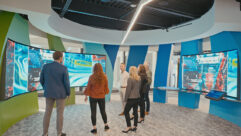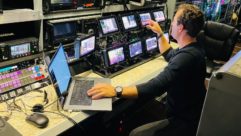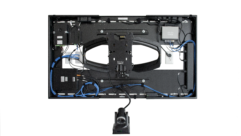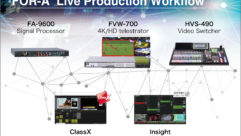
Installation Profile:
Standout Integration
Dec 1, 2005 12:00 PM,
By Jack Kontney
2005 Editors’ Choice Installations
Every installation presents its own problems. Some are predictable, some not. Customer requirements may prove challenging, or physical anomalies in a facility may prevent tried-and-true designs from being implemented. But finding ways to provide solutions that meet user needs through creative application of technology keeps this industry interesting.

Each of the 40 operating rooms at the University of Alabama Hospital are enhanced with a DVR and five surgical-grade flat-panel monitors.
Looking back at the installation projects we covered in 2005, we were impressed by the variety of problems that were addressed and the insightful solutions that were offered. We would be hard-pressed to declare one of them the best. So, after considerable discussion by the Sound & Video Contractor editorial staff, three different projects — a stadium renovation, a new teaching hospital, and an earthquake research lab — were chosen to get a second look as the top installs of the past year. We went back to the principals involved in these installations and asked if the installation was, in fact, all they thought it would be, whether course corrections had been made, and what the future might bring. As one might suspect from their inclusion here, the integrators and users involved in each install share satisfaction in a vision realized and a job well done. But future upgrades are inevitable.
As Keith Mignault, outgoing biomedical engineer at the University of Alabama, noted, “Every time you answer one question, you get two more.” Herewith, a review of the best installations of 2005.
ALLTEL STADIUM
This installation was formidable for its sheer size: a two-year renovation of Alltel Stadium, home of the NFL Jacksonville Jaguars. This installation included nearly 300 plasma monitors spread across five distinct venues with centralized control, each with its own audio and video challenges. The AV contractor was Florida Sound Engineering Company of Jacksonville, Fla., working with HOK Sport + Venue + Event, an architectural firm based in Kansas City, Mo. Bill Prescott, senior vice president of stadium operations for the team, led the project.
Beneath the new seating in the south end zone area is the Bud Zone, a full-fledged sports bar open to all ticket holders during games. The venue lives a second life as a year-round private party room. With 1,100 patrons filling its 16,000-square-foot space, giving everyone a clear view was the deceptively straightforward design goal.

The Instructional Facility at Cornell University’s School of Civil and Environmental Engineering incorporates a touchscreen display system and a video cart for ease of use.
“It was designed so that no matter where you are in there, you’re always looking at, at least, one TV,” says Ted Lopez, design architect and associate principal for HOK. To achieve this, approximately 50 Panasonic 37in. plasma monitors were strategically installed with mounting hardware from Chief Manufacturing. This also addressed one of HOK’s other design challenges: to create an attractive environment within what was, in essence, a concrete room.
The Bud Zone’s highly reflective structure created a definite audio problem. To ensure intelligibility, a BSS Audio Soundweb was commissioned. The speakers included JBL 28-T indoor/outdoor speakers, and an assortment of Atlas Sound ceiling speakers throughout, all powered by Crown CTs series amplifiers. “HOK did a great job with the architectural choices they made. When the AV system is turned on, it really makes the rooms come alive,” says Bob Cole of Florida Sound.
On the stadium’s upper level is the Terrace Suite, a more refined, high-end venue that seats 780. Here, the vibe is less raucous, but the visual requirements were the same. In this case, 37 more Panasonic 37in. screens were installed, augmented by seven 50in. models, creating a home theater-style environment. On the audio side, Florida Sound used the same components as the Bud Zone, adding Atlas Sound SM82T-B speaker clusters in the patio area. “They do a good job of the sound, not inundating you with it, but being strong enough to hear it,” Lopez says.
Two restaurant managers handle the video programming, so a user-friendly system was a necessity. Florida Sound’s solution relied on AMX NI-3000 and NI-4000 control systems, both fronted by AMX CA-10 color touchpanels. Operators choose from a number of video, satellite, and computer sources. Instead of network TV ads, customized programming targets specific venues within the stadium. Jacksonville-based Information and Display Systems handled the routing, installing a Maestro content management system, which uses HP PCs, a Windows 2000 server, a Sigma Electronics matrix router, and a Communications Specialties (CSI) Scan Do Pro scan converter.
The final phase of this project took place last year, with the renovation of the two Crown Royal Touchdown Clubs and the stadium’s 90 private suites. Holding 5,600 customers each, and with high-ambient-light conditions, these rooms were a definite challenge for good video. To beef up the existing array of Sony KV-20 and KV-25 monitors, Panasonic plasma displays were brought in. Various 37in., 42in., and 50in. models were placed throughout the venue. In addition, several video walls were installed, including four 10 1/2ft. × 6ft. units, and two more measuring 8ft. × 3 1/2ft. All the displays use rear-projection technology to provide crisp, vivid video, even in high ambient light. The displays were sourced from Scram Technologies. Another AMX control system orchestrates the action, while JBL 2142H loudspeakers mounted in Atlas Sound Q4412 enclosures provide audio via Crown amps.

The Alltel Stadium AV upgrade included close to 300 monitors and an assortment of loudspeakers augmented by several control systems in the Crown Royal Touchdown Clubs, Bud Zone, and Terrace Suite.
For the stadium’s 90 luxury suites, Alltel approved replacing the existing standard monitors with 42in. high-definition Panasonic TH42PX25U/P plasma screens. In the end, the team’s goal of enhancing the football experience for its customers was met. “When you’re in a place like this, you want to see the most current technology, and our goal was to make sure we put that in front of the fans. It’s to the credit of the Jaguars, who really committed to providing a great experience for their ticket holders,” Lopez says.
CORNELL UNIVERSITY
The earthquake study center at Cornell University in Ithaca, N.Y., is impressive for its unique needs. Part of the School of Civil and Environmental Engineering, the George Winter High Bay is a massive testing lab that simulates tectonic shifts in order to study the effects of large-scale ground movement on such human infrastructure as utility lines and communications systems. Adjacent to the high bay is the recently completed Richard N. White Instructional Facility, where students can conduct and directly observe experiments through glass viewing areas. The high bay is a key part of the George E. Brown Network for Earthquake Engineering Simulation (NEES), a consortium of 15 earthquake study centers around the United States.

Alltel Stadium in Jacksonville, Fla., featured in the April issue of Sound & Video Contractor.
Project goals included the upgrade and integration of the facility’s conferencing system to allow live video from the high bay and both data transmission and video images from distant NEES research centers to be selected as needed and viewed simultaneously. Audio-Video Corporation, East Syracuse, N.Y., integrated the specific product recommendations and installation.
The high bay facility is, in essence, a huge industrial warehouse with a 40ft. ceiling. To augment the three existing Sony PTZ video cameras capturing the tectonic research, one Sony EVI-D70 PTZ camera was added to the high bay and two more were placed in the classroom area. The high bay cameras rest 20ft. to 30ft. from the scenes they are covering. To get close to the action, a portable video setup was added, consisting of a ClearOne FlexCam gooseneck camera and wireless transmitter, and a Marshall Electronics LCD monitor, all mounted on a rolling video cart from Anthro Corporation. Each camera feeds its own server/streamer for the NEES system, while also sending directly into the classroom’s AV system.
The wireless camera unit operates in the unrestricted 2.4GHz frequency range, which is open to interference. In fact, there was already a potential conflict on campus with a wireless data terminal. Facilities project leader Greg Bronson coordinated frequency allocation with Cornell’s wireless data engineer and reports that no changes have been required since the original installation. The only issue has been multipath dropouts, so, like any wireless system, care must be taken with placement of the cart.

Cornell University’s School of Civil and Environmental Engineering Instructional Facility, featured in the March issue of Sound & Video Contractor.
For connection to other NEES research facilities, videoconferencing was upgraded with a Christie LW25U WXGA data/video projector in combination with a Crestron external image processor and a Crestron Isys TPS-3000 touchpanel controller. Using a 16:9 aspect ratio display area, a variety of content is viewable at the operator’s discretion, including a picture-outside-picture mode, PC desktop images, and separate views from the facility’s cameras. The touchpanel enables both a conferencing mode with split-screen video and a collaboration mode, which uses a full left-justified PC image and smaller video images tiled on the right. Widescreen processing fits it all onto a single screen while eliminating the image-block that is inherent in a picture-in-picture approach.
Bronson says the facility has already undergone some minor upgrades. “We had some extra expansion for the routers,” he says, “and upgraded the touchpanel a bit.” He already has his eye on future upgrades, specifically relating to a campus pilot project for streaming video over IP, which would create another content source for the facility.
One benefit inherent in a university engineering facility is that the staff is well equipped to take full advantage of the technology. Joe Rowe, the college’s director of administration, says they’re pleased with finished product. “The facility is excellent. The room is being used collaboratively for both teaching and research. The faculty and staff in the department are very happy with it.”

University of Alabama Hospital, featured in the June issue of Sound & Video Contractor.
UNIVERSITY OF ALABAMA HOSPITAL
One of the most certain indicators of the viability of today’s audio and video convergence is its application beyond the obvious areas of business communication and entertainment. A great example of this can be seen at the University of Alabama at Birmingham (UAB) Hospital, a new regional hospital and teaching facility. It should be no surprise that a full suite of AV and IP applications was required.
This 12-story, $275 million teaching hospital includes 40 operating rooms and an emergency room the size of a football field. One of the main goals was to maximize efficiency through technology in those rooms. Keith Mignault, a UAB biomedical engineer, spearheaded the AV system design. Mignault’s goal was to integrate all the operating rooms into a cohesive group via video, both for in-room viewing and for instructional use. His vision was realized with the help of two firms: Kontek Systems of Durham, N.C., and Image Stream Medical of Littleton, Mass.
The heartbeat of the system resides on the seventh floor, which houses the central video hub. The hub includes a huge 128×128 AutoPatch Epica router, which can handle three video signals from each operating room, using a combination of fiber optics and coaxial cable. Managing this massive signal flow is a Crestron control system, including touchpanel controls in each operating room, and Extron switchers and converters.
Because medical equipment runs the gamut of video standards, flexibility was a key design criterion. This affected equipment choices throughout the process, including wiring, monitors, and routers. Another key element was digital video recording. The Image Stream Medical DVR-MD is designed specifically for use in medical environments, enabling footswitch activation by the surgeon in situations where a routine operation suddenly becomes interesting. The DVR simultaneously records analog video in MPEG-2 format onto both a DVD and a hard disk, tagging it with doctor and patient information. A total of 42 Image Stream DVR-MDs were installed, serving to archive case materials while also creating content for classroom use.
Each operating room includes five surgical-grade flat-panel monitors from National Display Systems. Three are arrayed above the operating table on booms, a fourth is mounted on the central equipment column, and the fifth is deployed at the charting nurse’s station. Typically, the displays are used for patient vital signs and various video views, but in some cases, the monitors show images from endoscopic cameras or microscopic biopsy samples from the tissue lab.
In 15 of the operating rooms, an RGB Spectrum QuadView windowing device was incorporated, permitting up to four window views to be displayed on a single monitor. This allows a doctor to see a number of key data components at a glance. According to Mignault, this feature has proven popular with the medical staff, and it will likely be added to more operating rooms in the future.
The intensive video capability offers greatly improved efficiency, helping both the patient and the hospital. “Neurosurgery is significantly more efficient in how they do their turnarounds and case time, because everything is there for them to see, at their disposal. For those who do a lot of biopsies, case time has been shortened by being able to call it up on the screen instead of the doctor having to leave the room constantly. Patients are under anesthesia for shorter times, and that improves their recovery times,” Mignault says.
One of the design goals was to minimize the intrusion factor in each operating room, and get video displays and cameras up and out of the way. The charting nurse’s screen is the heart of the system, incorporating a Crestron touchpanel overlay. From here, video sources are selected, and camera, DVR, and light settings can be managed. Along with the DVR, a compact, stainless steel cabinet houses a Sony five-disc CD changer, allowing music to be played through the room’s JBL Control 26C speakers. An Audio-Technica miniature boundary mic is ceiling-mounted for audio capture.
To support the hospital’s teaching mission, all 40 operating rooms can send images to the teaching facilities (or to each other). For telemedicine sessions, surgeons are outfitted with an Audio-Technica wireless lavalier mic, and they receive audio through a Comtek IFB personal receiver. A Polycom Vortex echo-canceling system is used to prevent feedback. Eight of the operating rooms include a pair of RGBHV trunk lines so that hi-res images can be routed to the conference rooms in native resolution, including microscopic views.
Of course, delivering a high-tech installation like this brings higher expectations. “When you add new abilities like this, it encourages people to come forward and ask for additional things, like more simultaneous signals. And we’d like to be able to pre-cache the images the surgeon would like to pull up. That would improve efficiency,” Mignault says.
Mignault was quick to credit Kontek Systems and Image Stream Medical for their willingness to design a solution that was customized to UAB Hospital’s specific needs, and then to deliver what was promised. “As far as the rooms, they’ve been incredibly stable. The system as a whole has met and exceeded everything we asked for,” Mignault says.
For More Information
Anthro Corporation
www.anthro.com
AMX
www.amx.com
Atlas Sound
www.atlassound.com
Audio-Technica
www.audio-technica.com
AutoPatch
www.autopatch.com
BSS Audio
www.bssaudio.com
Chief Manufacturing
www.chiefmfg.com
ClearOne
www.clearone.com
Christie
www.christiedigital.com
Comtek
www.comtek.com
Crestron
www.crestron.com
Crown
www.crownaudio.com
Communications Specialties (CSI)
www.commspecial.com
Extron
www.extron.com
Image Stream Medical
www.imagestreammedical.com
Marshall Electronics
www.mars-cam.com
National Display Systemswww.nationaldisplay.com
Panasonic
www.panasonic.com
Polycom
www.polycom.com
RGB Spectrum
www.rgb.com
Scram Technologies
www.scramtech.com
Sigma Electronics
www.sigmaelectronics.com
Sony
www.sony.com
Jack Kontney is founder and president of Kontney Communications, a Chicago-area marketing communications consultancy specializing in the written word. He can be reached at[email protected].










